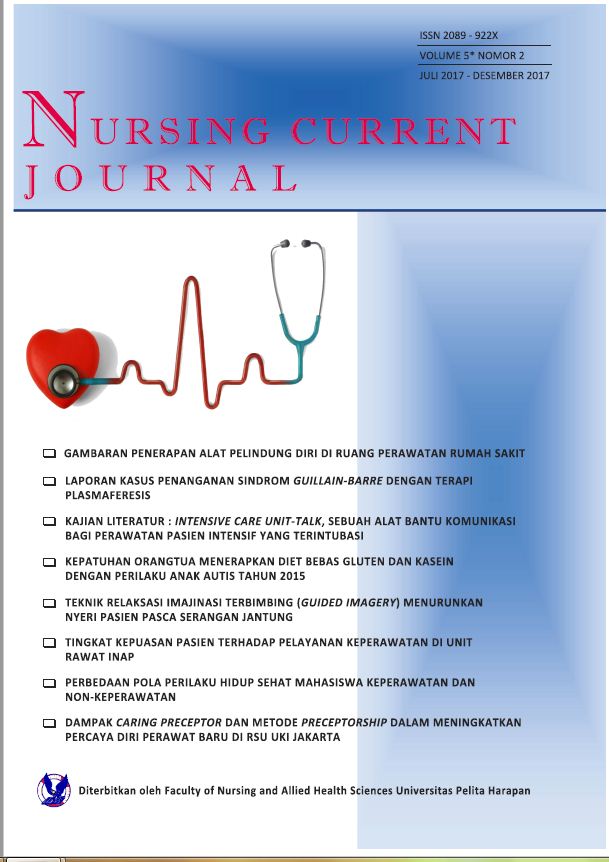DESCRIPTION OF THE APPLICATION OF PERSONAL PROTECTIVE EQUIPMENT IN A HOSPITAL[GAMBARAN PENERAPAN ALAT PELINDUNG DIRI DI RUANG PERAWATAN RUMAH SAKIT]
DOI:
https://doi.org/10.19166/nc.v5i2.1699Λέξεις-κλειδιά:
Nursing Care, Personal Protect Equipment, Patient SafetyΠερίληψη
Workplace safety in the hospital is an effort that must be done by all employees, including nurses while conducting tasks, one of them by using Personal Protective Equipment (PPE). Personal protective equipment in the hospital includes masks, gloves, dresses, etc. Compliance of health care workers, especially nurses, in the application of PPE greatly determines the safety of patients and other colleagues at the hospital. This study aimed at identifying the application of PPE in the treatment room at a private hospital in West Jakarta. The research design used was descriptive research. The study population was nurses who were in the nursing room at the hospital, a total of 31 nurses. Data was collected using convenient sampling technique involving 30 respondents through observation of nurses when giving nursing care in the inpatient rooms. The analytical method used univariate analysis. The results of this study showed out of 30 respondents, 75% (n = 22) used the PPE appropriately, while 25% (n = 8) did not. Future research can examine factors that cause nurses not apply the PPE in in-patient room when giving care.
BAHASA INDONESIA Keselamatan kerja di rumah sakit merupakan suatu upaya yang harus dilakukan seluruh pegawai, termasuk perawat selama melakukan tugas, salah satunya dengan menggunakan Alat Pelindung Diri (APD). Alat pelindung diri di rumah sakit mencakup masker, sarung tangan, gaun, dan sebagainya. Kepatuhan tenaga perawatan kesehatan, khususnya tenaga perawat, dalam penerapan APD sangat menentukan keselamatan pasien dan rekan kerja lain di rumah sakit tersebut. Penelitian ini bertujuan mengidentifikasi penerapan APD di ruang perawatan di sebuah rumah sakit swasta di Jakarta Barat. Desain penelitian yang digunakan adalah penelitian deskriptif. Populasi penelitian adalah perawat yang berada di ruang perawatan di rumah sakit tersebut, sejumlah 31 perawat. Pengambilan responden dengan teknik convenient sampling dengan jumlah 30 responden. Pengambilan data dilakukan dengan cara observasi perawat ketika melakukan asuhan keperawatan di ruang perawatan. Metode analisis yang digunakan analisis univariat. Hasil penelitian ini menunjukkan dari 30 responden, 75 % (n=22) di antaranya menerapkan penggunaan APD, sedangkan 25% (n=8) tidak menerapkan penggunaan APD. Peneliti selanjutnya dapat meneliti faktor faktor penyebab perawat tidak melakukan penerapan APD di ruang perawatan.
Αναφορές
Banda, I. (2015). Hubungan Perilaku Perawat Dengan Kepatuhan Menggunakan Alat Perlindungan Diri (APD) Sesuai Standart Operating Procedure (SOP) di Ruang Rawat Inap BLUD Rumah Sakit KONAWE Tahun 2015 [Skripsi yang belum dipublikasi]. Fakultas Kesehatan Masyarakat, Universitas Haluoleo, Kendari.
Harwanti, N. (2009). Pemakaian Alat Pelindung Diri Dalam Memberikan Perlindungan Bagi Tenaga Kerja Di Instalasi Rawat Inap I RSUP Dr. Sardjito Yogyakarta [Skripsi, Fakultas Kedokteran Universitas Sebelas Maret, Surakarta]. Universitas Sebelas Maret. http://eprints.uns.ac.id/5675/1/103910110200908051.pdf
Peraturan.go.id. (n.d.). Peraturan.go.id. https://peraturan.go.id/
Republik Indonesia. (n.d.) Undang-Undang RI nomor 23 Tahun 1992 Tentang Kesehatan. https://kink.onesearch.id/Record/IOS2898.slims-9839/Details
World Health Organization. (2015, January 29). WHO updates personal protective equipment guidelines for ebola response. World Health Organization. https://apps.who.int/mediacentre/news/releases/2014/ebola-ppe-guidelines/en/index.html
Λήψεις
Δημοσιευμένα
Πώς να δημιουργήσετε Αναφορές
Τεύχος
Ενότητα
Άδεια
Authors who publish with this journal agree to the following terms:
1) Authors retain copyright and grant the journal right of first publication with the work simultaneously licensed under a Creative Commons Attribution License (CC-BY-SA 4.0) that allows others to share the work with an acknowledgement of the work's authorship and initial publication in this journal.
2) Authors are able to enter into separate, additional contractual arrangements for the non-exclusive distribution of the journal's published version of the work (e.g., post it to an institutional repository or publish it in a book), with an acknowledgement of its initial publication in this journal.
3) Authors are permitted and encouraged to post their work online (e.g., in institutional repositories or on their website). The final published PDF should be used and bibliographic details that credit the publication in this journal should be included.

This work is licensed under a Creative Commons Attribution-ShareAlike 4.0 International License.






